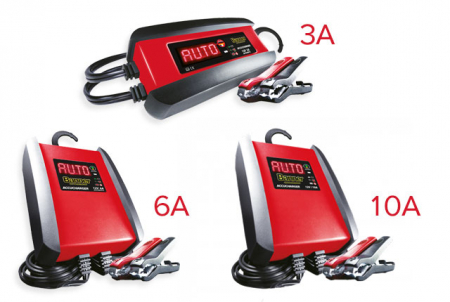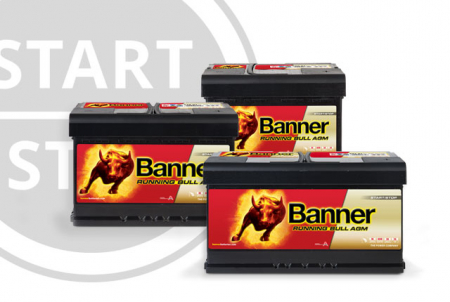WINTERISING A MOTORHOME
TIPS AND TRICKS FOR THE WINTER BREAK
Do you have a camper, motor home or caravan and are putting it away for the winter? Banner Batteries provides tips for optimum winter storage of the vehicle and battery. When not in use and at a standstill for a longer period (idle or winter storage period), you basically have several options for your starter and on-board battery, with AGM Technology, for successful winterising. This depends on whether the area where you are hibernating your vehicle has a power connection or the possibilities of your charger.

Which charger do I need to use?
As a general rule, fully automatic chargers (charging voltage limited to 14.8 V) are well suited for charging the battery installed in a vehicle. These charging devices are fully automatic. Depending on the battery’s capacity, you can use the following chargers, all with charge retention function:
- Batteries up to 72 Ah - Banner Accucharger 12V 3A
- Batteries up to 130 Ah - Banner Accucharger 12V 6A Recovery
- Batteries up to 230 Ah - Banner Accucharger 12V 10A Recovery
If you already have a charger, please take note of the following information:
Use the AGM setting, the charging voltage should be max. 14.8 V and the retention charging voltage should be set to 13.5 V. It would be best to use an IUoU characteristic with temperature compensation (if you have the option of adjusting it).
We also recommend the battery tester so that you can periodically check the battery voltage. BBT DBA - Digital Battery Analyser
Parking space without electricity
If no power connection is available, then the battery should be stored in a dry and cool frost-free) place. Before storage, fully charge the battery and recharge it at the latest at an off-load voltage of 12.5 V or leave it connected to the charger with charge retention. Please use voltage-controlled chargers (Banner Accucharger, max. 14.8 V) with automatic switching to charge retention. These charging devices are fully automatic.
Parking space with electricity
Should the battery be removed for recharging to avoid damage to the vehicle? Please pay attention to the type of charger. In many cases, valuable tips for charging in the vehicle can be found in the operating instructions of the vehicle manufacturer or in those of the charger manufacturer. As a general rule, fully automatic chargers (charging voltage limited to 14.8 V) are well suited for charging the battery installed in a vehicle.
If a charger limited to a voltage of 14.8 V is used, then disconnect the battery in the motorhome and connect it to a charge maintenance device (e.g. Banner Accucharger with max. 14.8 V).
Caution: Follow the vehicle manufacturer’s instructions when disconnecting. If you already have a charger, note the following information: Use the AGM setting. The charging voltage should be max. 14.8 V and the float charge voltage should be set to 13.5 V. It would be best to use an IUoU characteristic with temperature compensation (if you have the option of adjusting it). To get the maximum life out of the battery, please ensure that it is completely disconnected from the on-board power supply during the idle period (>7 days)
If your charger operates at a higher voltage level up to >14.8 V , then please do not use it for charging AGM batteries. Why? The use of conventional, non-voltage-controlled chargers destroys the AGM battery by overcharging and causes the electrolyte to escape. In the worst case, the installed control units - if the battery is not disconnected - could be destroyed by overvoltages.

Banner charging tips for AGM batteries
- Only use direct current to charge the batteries.
- Battery disconnected or removed: Connect the positive terminal (+) of the battery to the (+) terminal of the charger and the negative terminal (-) to the (-) terminal of the charger.
- Battery not disconnected or removed: Connect the positive terminal (+) of the battery to the charging terminal (+) of the charger and clamp the negative terminal (-) of the charger to earth (= unpainted body, metallic bare spot).
- Do not switch on the charger until the battery has been connected. When charging is finished, switch off the charger first.
- We recommend a charging current of approx. one-tenth of the capacity (e.g. 60 Ah / 10 = 6 A charging current). With automatic chargers like the Banner Accucharger, this setting is performed automatically.
- If a temperature of +55 °C is exceeded, you must stop charging the battery.
- Ensure good ventilation when charging.
- The screw connections of the AGM batteries must not be opened. It is not possible or necessary to measure the acid density or top up with distilled water.
- Please note that 1.2 times the removed capacity must be charged back again (e.g. removed capacity 30 Ah --> Recharge 36 Ah).
- The battery is fully charged when the current drops to 0 or no longer decreases or the automatic charger switches off itself.
Caution: An explosive oxygen-hydrogen mix can form during charging. Fire, sparks, naked flames and smoking are prohibited.

For a long service life of a starter and on-board battery with AGM technology
It is essential that you check the open-circuit voltage with a battery tester or voltmeter. Please make sure to recharge the battery as soon as an open-circuit voltage limit of 12.5 V has been reached. In order to be able to measure the open-circuit voltage with a tester, wait until approx. five hours after the end of charging or do not discharge for at least one hour.
An AGM battery should only be discharged to a maximum of 50% of its charge level.
In general, the deeper the discharge, the shorter the expected service life. An AGM battery can achieve up to 400 cycles at a discharge depth of 50% (approx. 12.3 V open-circuit voltage).
By following these cast-iron tips, you and your vehicle with battery are guaranteed a successful new travel season, without any unplanned pit stops. Because next summer is definitely on its way.
You might also be interested in the following

